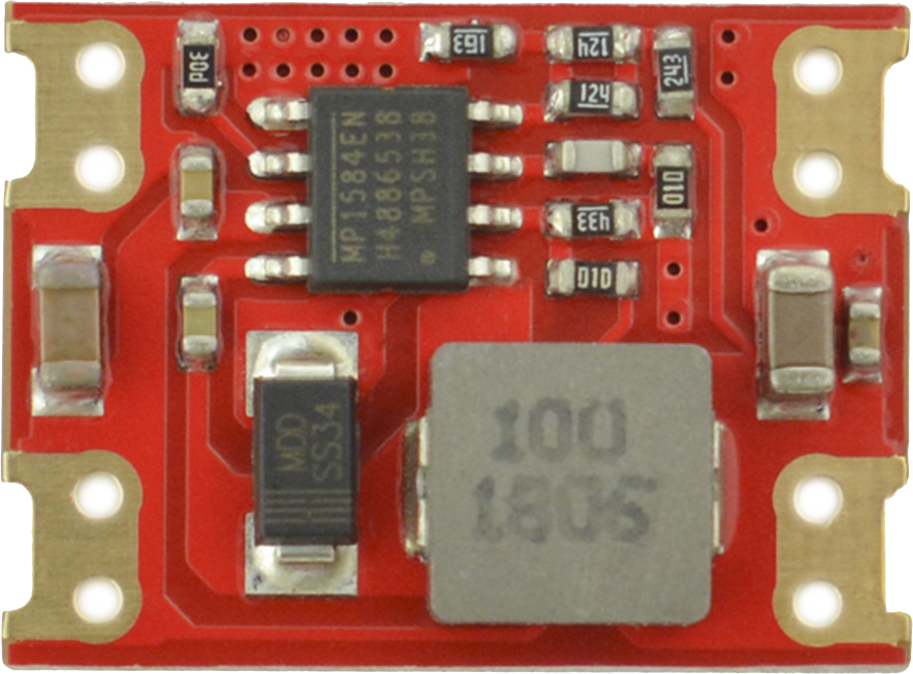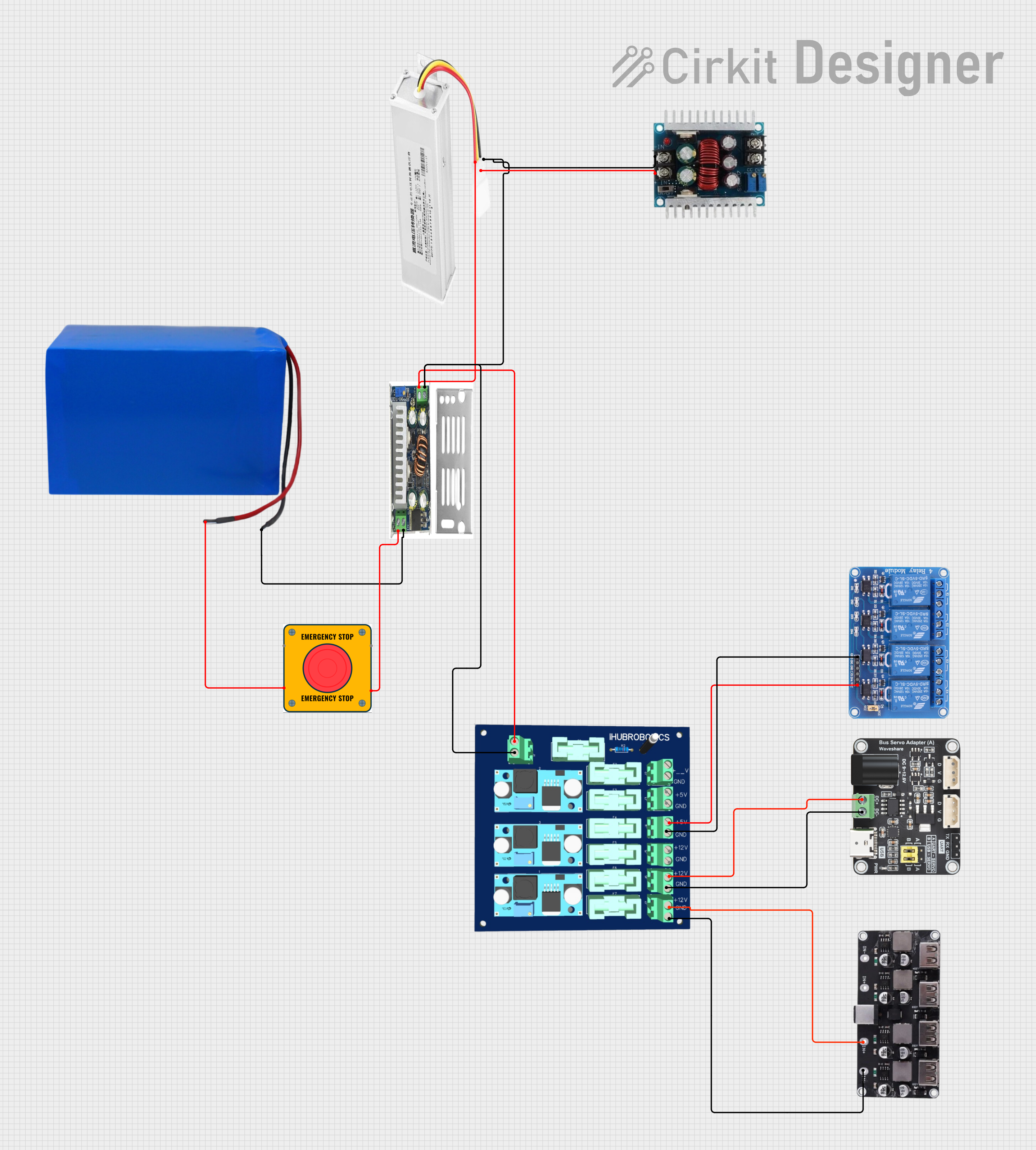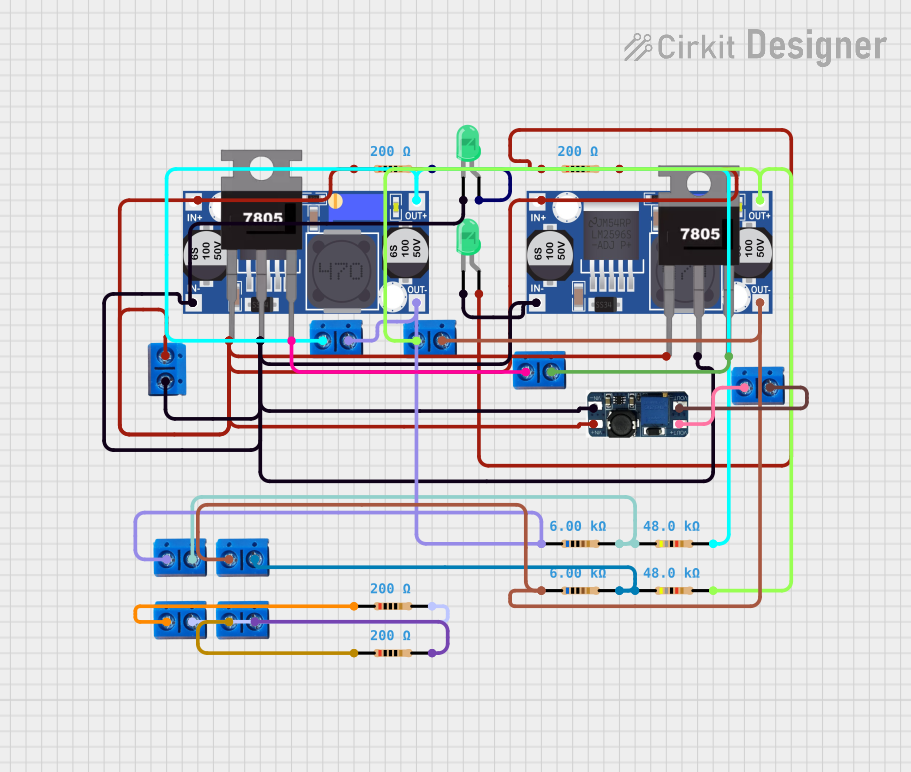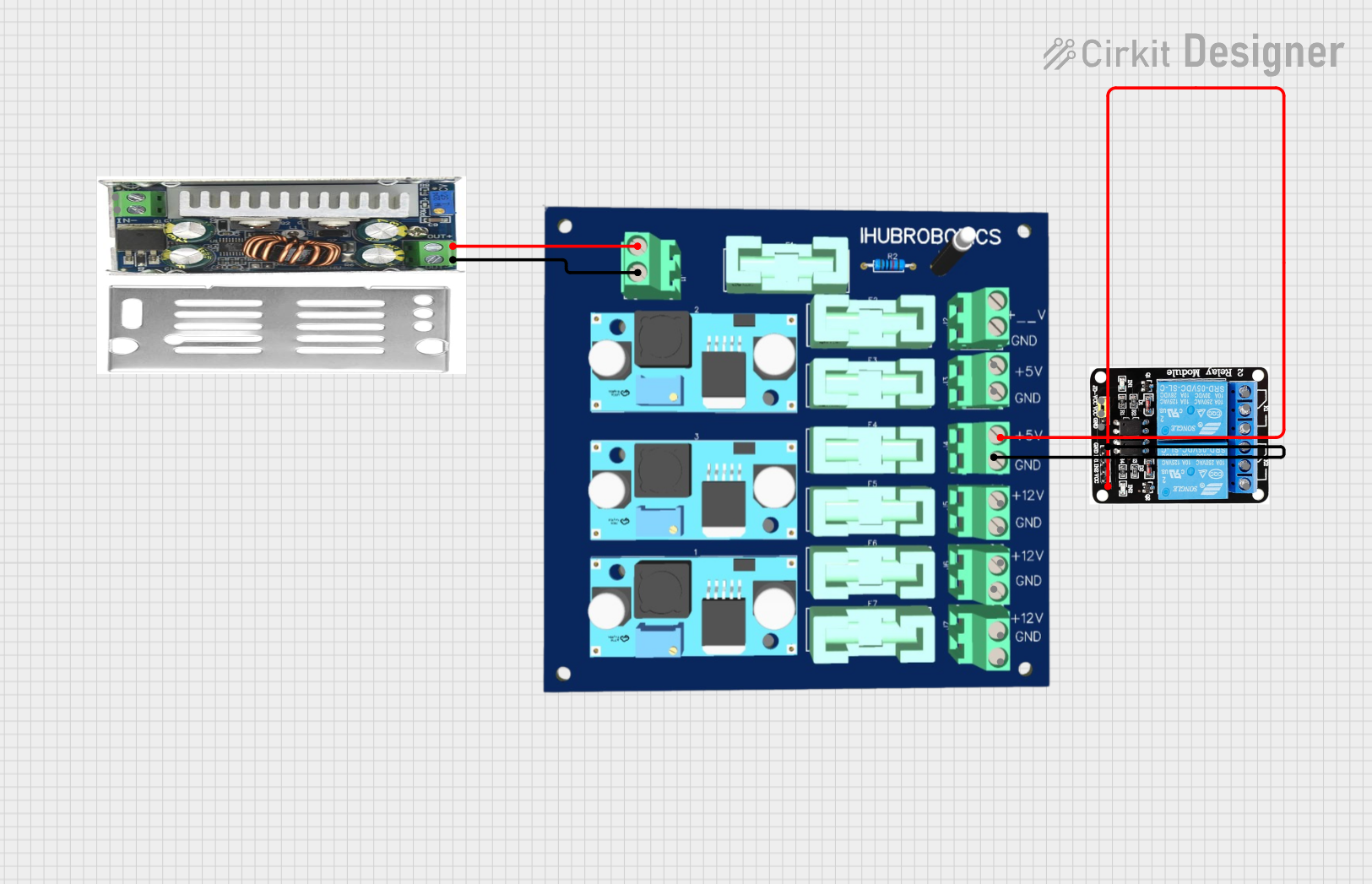
How to Use DC-DC Buck-Mode Power Module (8~28V to 5V 1.6A): Examples, Pinouts, and Specs

 Design with DC-DC Buck-Mode Power Module (8~28V to 5V 1.6A) in Cirkit Designer
Design with DC-DC Buck-Mode Power Module (8~28V to 5V 1.6A) in Cirkit DesignerIntroduction
The DC-DC Buck-Mode Power Module (DFR0571), manufactured by DFRobot, is a compact and efficient step-down voltage regulator. It converts a higher input voltage (ranging from 8V to 28V) to a stable 5V output, capable of delivering up to 1.6A of current. This module is ideal for powering low-voltage devices such as microcontrollers, sensors, and other 5V-compatible electronics.
Explore Projects Built with DC-DC Buck-Mode Power Module (8~28V to 5V 1.6A)

 Open Project in Cirkit Designer
Open Project in Cirkit Designer
 Open Project in Cirkit Designer
Open Project in Cirkit Designer
 Open Project in Cirkit Designer
Open Project in Cirkit Designer
 Open Project in Cirkit Designer
Open Project in Cirkit DesignerExplore Projects Built with DC-DC Buck-Mode Power Module (8~28V to 5V 1.6A)

 Open Project in Cirkit Designer
Open Project in Cirkit Designer
 Open Project in Cirkit Designer
Open Project in Cirkit Designer
 Open Project in Cirkit Designer
Open Project in Cirkit Designer
 Open Project in Cirkit Designer
Open Project in Cirkit DesignerCommon Applications
- Powering microcontrollers like Arduino, Raspberry Pi, or ESP32.
- Supplying stable 5V power to sensors, relays, and other peripherals.
- Battery-powered systems requiring efficient voltage regulation.
- Automotive electronics where 12V or 24V systems need to power 5V devices.
Technical Specifications
Below are the key technical details of the DFR0571 module:
| Parameter | Value |
|---|---|
| Input Voltage Range | 8V to 28V |
| Output Voltage | 5V (fixed) |
| Maximum Output Current | 1.6A |
| Efficiency | Up to 96% |
| Operating Temperature | -40°C to +85°C |
| Dimensions | 22mm x 17mm x 4mm |
| Weight | 3g |
Pin Configuration and Descriptions
The module has three main pins for input and output connections:
| Pin Name | Description |
|---|---|
| VIN | Input voltage (8V to 28V) |
| GND | Ground (common for input and output) |
| VOUT | Regulated 5V output |
Usage Instructions
How to Use the Component in a Circuit
Connect Input Voltage:
- Connect the positive terminal of your power source (8V to 28V) to the
VINpin. - Connect the negative terminal of your power source to the
GNDpin.
- Connect the positive terminal of your power source (8V to 28V) to the
Connect Output Load:
- Connect the
VOUTpin to the positive terminal of your 5V device or load. - Connect the
GNDpin to the ground of your load.
- Connect the
Verify Connections:
- Double-check all connections to ensure proper polarity and avoid short circuits.
Power On:
- Turn on the power source. The module will regulate the input voltage to a stable 5V output.
Important Considerations and Best Practices
- Input Voltage Range: Ensure the input voltage is within the specified range (8V to 28V). Exceeding this range may damage the module.
- Heat Dissipation: Although the module is highly efficient, prolonged operation at maximum current (1.6A) may generate heat. Ensure adequate ventilation or consider adding a heatsink if necessary.
- Polarity Protection: The module does not have built-in reverse polarity protection. Always connect the input voltage with the correct polarity.
- Load Requirements: Do not exceed the maximum output current of 1.6A to prevent damage to the module or connected devices.
Example: Using with Arduino UNO
The DFR0571 module can be used to power an Arduino UNO from a 12V power source. Below is an example circuit and Arduino code:
Circuit Connections
- Connect the 12V power source to the
VINandGNDpins of the module. - Connect the
VOUTpin of the module to the5Vpin of the Arduino UNO. - Connect the
GNDpin of the module to theGNDpin of the Arduino UNO.
Arduino Code Example
// Example code to blink an LED connected to pin 13 of Arduino UNO
// Ensure the Arduino is powered via the DFR0571 module
void setup() {
pinMode(13, OUTPUT); // Set pin 13 as an output
}
void loop() {
digitalWrite(13, HIGH); // Turn the LED on
delay(1000); // Wait for 1 second
digitalWrite(13, LOW); // Turn the LED off
delay(1000); // Wait for 1 second
}
Troubleshooting and FAQs
Common Issues and Solutions
No Output Voltage:
- Cause: Input voltage is below 8V or connections are incorrect.
- Solution: Verify that the input voltage is within the 8V to 28V range and check all connections.
Overheating:
- Cause: Module is operating at maximum current (1.6A) for extended periods or poor ventilation.
- Solution: Improve ventilation or add a heatsink to the module.
Output Voltage Fluctuations:
- Cause: Input voltage is unstable or load exceeds 1.6A.
- Solution: Use a stable power source and ensure the load does not exceed the module's current rating.
Module Not Working After Connection:
- Cause: Reverse polarity or input voltage exceeded 28V.
- Solution: Check polarity before connecting and ensure the input voltage is within the specified range.
FAQs
Q1: Can this module be used to power a Raspberry Pi?
A1: Yes, the module can power a Raspberry Pi, but ensure the total current draw (including peripherals) does not exceed 1.6A.
Q2: Does the module have short-circuit protection?
A2: No, the module does not have built-in short-circuit protection. Use external protection if needed.
Q3: Can I adjust the output voltage?
A3: No, the output voltage is fixed at 5V and cannot be adjusted.
Q4: Is the module suitable for automotive applications?
A4: Yes, the module can be used in automotive applications, as it supports input voltages up to 28V, commonly found in 12V and 24V systems.